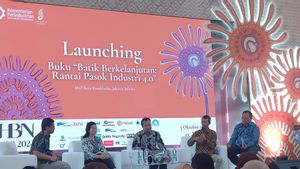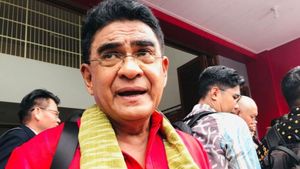JAKARTA - Hilmar Farid, Director General of Culture of the Ministry of Education, Culture, Research and Technology (Kemendikbudristek), emphasized that the role of the younger generation is very important in efforts to advance batik culture in Indonesia to further develop.
"This responsibility will be on the shoulders of the younger generation, who come with fresh ideas to develop batik. I believe that our talents and abilities in this matter are very adequate," said Hilmar as quoted by Antara.
Hilmar explained that the role of young people in preserving batik has been proven in various important moments, one of which was when UNESCO established batik as a Cultural Heritage of Takbenda 15 years ago.
After UNESCO's confession, the 6th President of the Republic of Indonesia Susilo Bambang Yudhoyono initiated a movement to wear batik every Friday.
According to Hilmar, the popularity of the movement to wear batik on Friday cannot be separated from the enthusiasm of the younger generation. This spirit makes the use of batik in everyday life wider and creates a new culture in society.
"The use of batik is no longer limited to formal events. Batik has developed into a lifestyle, with a variety of innovations that continue to emerge," he added.
However, Hilmar also highlighted that although many large fashion industries have included batik in their collections, this does not always provide direct benefits for craftsmen.
Therefore, the importance of advancing batik culture involving the younger generation is in line with the mandate of Law Number 5 of 2017 concerning the Advancement of Culture.
SEE ALSO:
Batik should not only be a proud legacy, but also develop and have a real impact, including improving the welfare of craftsmen, said Hilmar.
One of the efforts that need to be encouraged is the management of batik as a national intellectual property. This is important so that batik continues to grow according to the changing times, but is still protected legally.
For example, the development of batik in West Java. Before 2008, only a few areas such as Cirebon, Tasikmalaya, Indramayu, Garut, and Ciamis were known as batik centers. However, with the presence of the West Java Batik Foundation (YBJB), now batik art has spread across 27 districts and cities in the province.
"If the intellectual property of batik is not managed properly, there is a risk that outsiders will take advantage of and claim our batik. In the end, those who are harmed remain domestic craftsmen," said Hilmar.
He emphasized that all elements of society need to work together to ensure batik is protected as an intellectual property. In addition, innovation must continue to be encouraged so that batik is not only an economic product, but also an important part of the nation's identity and cultural defense.
"This is our common task, ensuring that everyone plays a role in maintaining and managing batik intellectual property. That way, batik can be an economic driver while strengthening the identity of Indonesian culture," concluded Hilmar.
The English, Chinese, Japanese, Arabic, and French versions are automatically generated by the AI. So there may still be inaccuracies in translating, please always see Indonesian as our main language. (system supported by DigitalSiber.id)

















